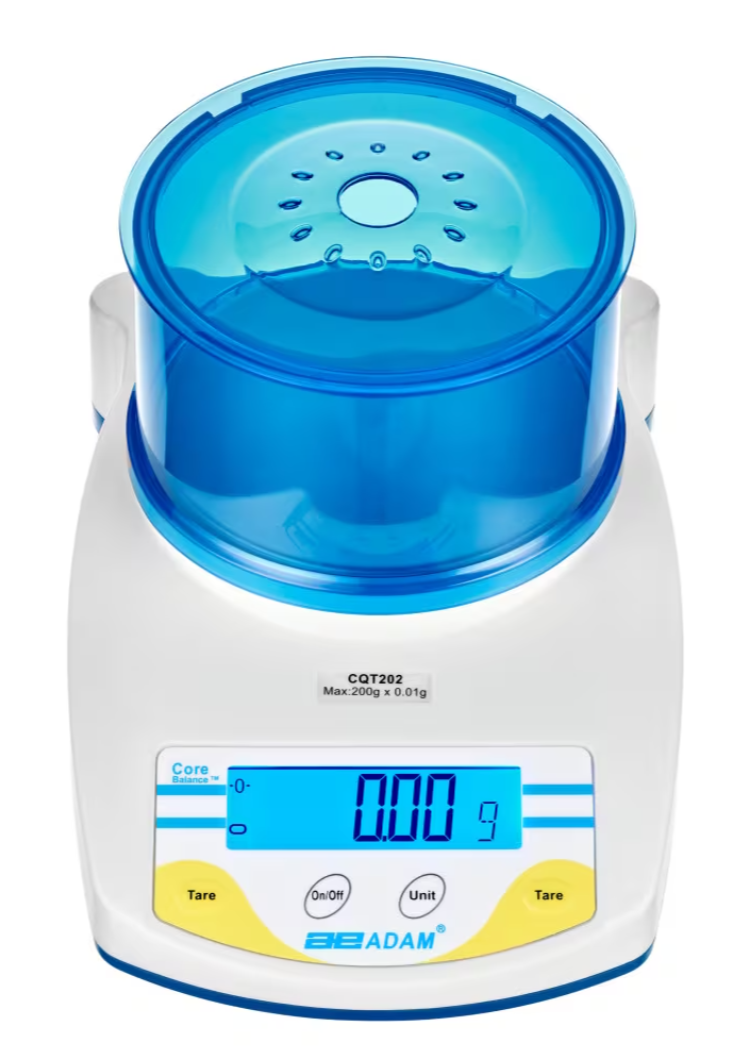Portable Compact Balances CQT
The Core is an outstanding value, providing easy operation and a portable solution for any basic precision weighing tasks. An innovative stackable design saves space, so the Core lends itself well to science classrooms or busy labs.
Offering precision results, Core is suitable for weighing compounds in science classrooms, samples at a field lab, ingredients in food labs and specimens at veterinary offices. The Core includes a convenient weigh-below hook, facilitating below-balance weighing for tasks requiring density and specific gravity measurements.
Overview
Core Portable Precision Balances: Compact, Durable, and Versatile
The Core balance delivers exceptional value with its user-friendly operation and portable design, making it perfect for basic precision weighing tasks. Its innovative stackable feature saves space, making it ideal for science classrooms, busy laboratories, and fieldwork environments. Providing reliable and accurate results, the Core is suitable for weighing compounds in science labs, samples in field studies, ingredients in food testing, and specimens in veterinary practices. A built-in weigh-below hook enhances functionality, enabling below-balance weighing for density and specific gravity measurements.
Features and Benefits:
- Bright Backlit LCD: Ensures easy readability in any lighting condition.
- Programmable Backlight: Customise settings to "always on," "always off," or activate only during weighing.
- Space-Saving Design: Stackable for efficient and safe storage (120mm pan size only).
- Colour-Coded Keys: Simplifies operation with quick access to frequently used functions.
- Dual Tare Keys: Accessible for both left- and right-handed users.
- Stainless Steel Pan: Durable, grade 304 surface ensures easy cleaning and long-term reliability.
- Rugged Construction: Built to withstand daily use in industrial and classroom environments.
- ShockProtect® Technology: Three-point system protects internal components from overload damage.
The Core Portable Precision Balance combines convenience, accuracy, and durability, making it a trusted tool for education, research, and professional applications.
Specifications
- Dimensions
-
CQT 202 CQT 251 CQT 601 CQT 1501 CQT 2000 CQT 2601 CQT 5000 Overall Dimensions WxDxH (mm) 171x250x80 - Technical Specifications
-
CQT 202 CQT 251 CQT 601 CQT 1501 CQT 2000 CQT 2601 CQT 5000 Capacity 200g 250g 600g 1500g 2000g 2600g 5000g Readability 0.01g 0.1g 0.1g 0.1g 1g 0.1g 1g Repeatability (S.D.) 0.02g 0.1g 0.1g 0.1g 1g 0.1g 1g Linearity (+/-) 0.02g 0.1g 0.1g 0.2g 1g 0.2g 1g Pan Size 120mm ø 145mm ø Weighing Units g, kg, lb, oz, N, GN, ct, dr, tl.T Stabilisation Time (sec) 2 Calibration External calibration Display Backlit LCD with 18mm-high digits Power Supply 12VAC 50/60Hz 150mA adapter / 6 x AA batteries Operating Temperature 0° to 40°C Housing ABS plastic Draught Shield Round 130mm ø x 90mm N/A Net Weight 0.9kg
Downloads
Support & FAQs
At Thermoline, we strive to supply helpful customer support to ensure that you get the most out of our products. We are committed to providing whatever support our customers need, wherever they are in the world. If you can't find your solution in the below FAQs or Knowledge Base, please contact our friendly support team.
- What is laboratory balance?
A laboratory balance is a precision instrument used to measure the mass of an object or sample. It is designed for use in laboratory settings and is typically more accurate and precise than a standard scale.
A laboratory balance typically consists of a weighing platform, a load cell to measure the weight of the sample, and a digital display that shows the result. The load cell converts the force of gravity acting on the sample into an electrical signal, which is then displayed on the digital display.
- What is the difference between a scale and a balance?
While scales and balances are both used as weighing devices, their intended purposes vary slightly.
A scale is used to measure weight (weight = the force of gravity on an object on the scale), whereas a balance is used to measure mass. (mass = the amount of matter in an object). A scale is a general-purpose measuring instrument that gives an estimate of the weight of an object. They typically use spring mechanisms to measure weight and have a lower precision compared to laboratory balances.
A balance, on the other hand, is a highly precise instrument used in laboratory settings. Balances use load cells to measure weight and provide a much higher level of accuracy compared to scales. The readout on a balance is usually digital, and the results can be displayed in various units of measurement, including grams, kilograms, and ounces.
- What are the appropriate conditions for a laboratory balance?
- You should first install the balance in a workroom free of vibrations and shakes and where there is no air draft or dust. You want to ensure that the ambient temperature is between +15°C and +35°C while ensuring that the relative humidity is not above 80%. Place the balance either on a robust-design table or on a wall bracket that is both distant from heat sources and insusceptible to vibrations.
- What is the difference between a precision balance and an analytical balance?
Precision balances and analytical balances are both types of laboratory balances, but they differ in their level of precision and the types of applications for which they are used.
A precision balance is a type of laboratory balance that provides accurate measurements within a range of ±0.1 to ±0.01 grams. Precision balances are typically used for routine weighing tasks, such as determining the mass of chemicals for routine laboratory experiments, or for checking the weight of small parts in industrial settings.
An analytical balance, on the other hand, is a highly precise type of laboratory balance that provides accurate measurements within a range of ±0.0001 grams. Analytical balances are used for more demanding applications, such as determining the mass of samples for highly accurate chemical analysis, or for weighing minute quantities of substances in medical and pharmaceutical research.





